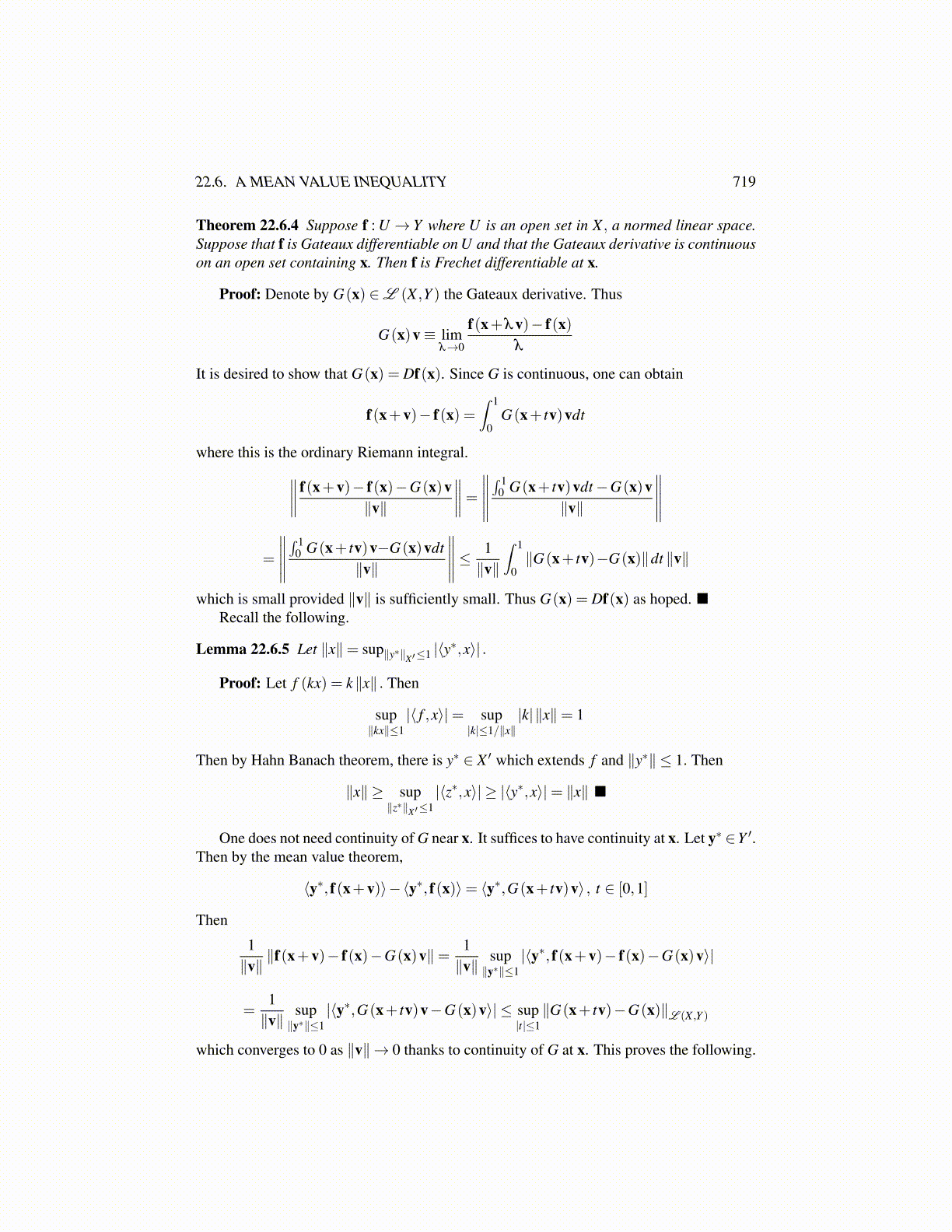
22.6. A MEAN VALUE INEQUALITY 719
Theorem 22.6.4 Suppose f : U → Y where U is an open set in X , a normed linear space.Suppose that f is Gateaux differentiable on U and that the Gateaux derivative is continuouson an open set containing x. Then f is Frechet differentiable at x.
Proof: Denote by G(x) ∈L (X ,Y ) the Gateaux derivative. Thus
G(x)v≡ limλ→0
f(x+λv)− f(x)λ
It is desired to show that G(x) = Df(x). Since G is continuous, one can obtain
f(x+v)− f(x) =∫ 1
0G(x+ tv)vdt
where this is the ordinary Riemann integral.∥∥∥∥ f(x+v)− f(x)−G(x)v∥v∥
∥∥∥∥=∥∥∥∥∥∫ 1
0 G(x+ tv)vdt−G(x)v∥v∥
∥∥∥∥∥=
∥∥∥∥∥∫ 1
0 G(x+ tv)v−G(x)vdt∥v∥
∥∥∥∥∥≤ 1∥v∥
∫ 1
0∥G(x+ tv)−G(x)∥dt ∥v∥
which is small provided ∥v∥ is sufficiently small. Thus G(x) = Df(x) as hoped.Recall the following.
Lemma 22.6.5 Let ∥x∥= sup∥y∗∥X ′≤1 |⟨y∗,x⟩| .
Proof: Let f (kx) = k∥x∥ . Then
sup∥kx∥≤1
|⟨ f ,x⟩|= sup|k|≤1/∥x∥
|k|∥x∥= 1
Then by Hahn Banach theorem, there is y∗ ∈ X ′ which extends f and ∥y∗∥ ≤ 1. Then
∥x∥ ≥ sup∥z∗∥X ′≤1
|⟨z∗,x⟩| ≥ |⟨y∗,x⟩|= ∥x∥
One does not need continuity of G near x. It suffices to have continuity at x. Let y∗ ∈Y ′.Then by the mean value theorem,
⟨y∗, f(x+v)⟩−⟨y∗, f(x)⟩= ⟨y∗,G(x+ tv)v⟩ , t ∈ [0,1]
Then
1∥v∥∥f(x+v)− f(x)−G(x)v∥= 1
∥v∥sup∥y∗∥≤1
|⟨y∗, f(x+v)− f(x)−G(x)v⟩|
=1∥v∥
sup∥y∗∥≤1
|⟨y∗,G(x+ tv)v−G(x)v⟩| ≤ sup|t|≤1∥G(x+ tv)−G(x)∥L (X ,Y )
which converges to 0 as ∥v∥→ 0 thanks to continuity of G at x. This proves the following.